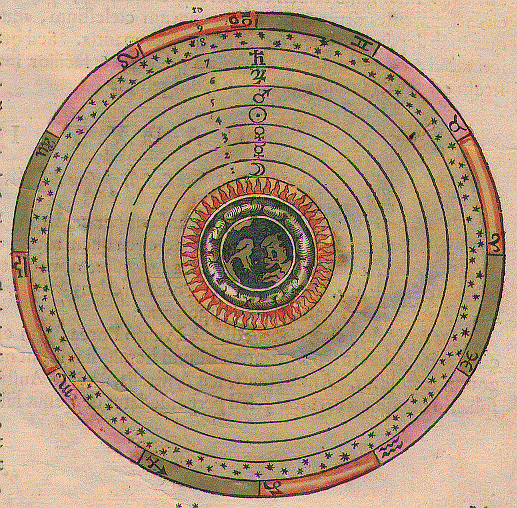
The Aristotelian cosmos. The Earth sits motionless at the center of the universe, and the outer sphere, the Primum Mobile, is assumed to undergo a full revolution in 24 hours.
Great Moments in the History of Solar Physics (1)
1223 BC-1644
Go to later Great Moments
1223 BC: The oldest eclipse record
Total eclipses of the Sun are arguably the most impressive astronomical phenomenon that can be observed more or less regularly with the naked eye (see slides 9 and slide 10 of the HAO slide set The Sun: A Pictorial Introduction). They occur when the Moon reaches a point in its orbit around the Earth that lies on the line joining the Earth and Sun. By a remarkable coincidence, the Moon's angular diameter, as seen from the Earth, is almost identical to that of the Sun. The Sun's disk is then completely eclipsed, and daytime darkness falls upon the Earth for a few minutes (This physical explanation of the phenomenon was only put forth much later, in the first century BC). Like comets, solar eclipses were taken to be astrological omens of great significance. It is therefore not surprising that such a spectacular event is often mentioned in surviving written records and chronicles of ancient civilizations.
The oldest eclipse record is found on a clay tablet uncovered in the ancient city of Ugarit, (in what is now Syria), with two plausible dates usually cited: 3 May 1375 BC or 5 March 1223 BC, the latter being favored by most recents authors on the topic. It is certainly clear that by the eight century BC, the Babylonians were keeping a systematic record of solar eclipses, and may even have been able to predict them fairly accurately based on numerological rules.
References and further reading:
Fotheringham, J.K. 1933, The Story of Hi and Ho, Journal of the British Astronomical Association, 43, 248-257.
Zirker, J.B. 1995, Total Eclipses of the Sun, Princeton University Press.
Littman, M., Willcox, F., and Espenak, F. 2000, Totality: Eclipses of the Sun, 2nd ed., Oxford University Press
| Chronological menu | Biographical index | Index of images |
--------------------------------------------------------------------------------
ca. 800 BC: The first plausible recorded sunspot observation
Sunspots are concentrations of strong magnetic fields piercing the solar photosphere. Visually, they look like dark blemishes on the solar disk (see slide 1 and slide 3 of the HAO slide set). Most sunspots are too small to be readily visible by naked eye observations, but some reach a size sufficient to be visible without a telescope, under suitable viewing conditions (for example, when the sun is partially obscured by fog or thick mist, or clouds). Because of their possible astrological significances, reports of naked-eye sunspot observations are indeed to be found in many ancient chronicles and court chronologies.
The two oldest record of a sunspot observation are found in the Book of Changes, probably the oldest extant Chinese book, compiled in China around or before 800 BC. The text reads "A dou is seen in the Sun", and ''A mei is seen in the Sun". From the context, the words (i.e., chinese characters) "dou" and "mei" are taken to mean darkening or obscuration.
Astronomers at the court of the Chinese and Korean emperors made regular notes of sunspots, most less elliptical than the one cited above. It seems, however, that observations were not carried out systematically for their own sake, but instead took place whenever astrological prognostication was demanded by the emperor. The surviving sunspots records, though patchy and incomplete, covers nearly 2000 years and represents by far the most extensive pre-telescopic sunspot record.
References and further reading:
Mossman, J.E., 1989, A comprehensive search for sunspots without the aid of a telescope, 1981-1982, in Quarterly J. R. Astr. Soc., 30, 59-73.
Stephenson, F.R. 1990, Historical evidence concerning the Sun: interpretation of sunspot records during the telescopic and pre-telescopic eras, in Phil. Trans. R. Soc. London, A330, 499-512.
Hetherington, B. 1996, A chronicle of pre-telescopic astronomy, John Wiley and Sons.
| Chronological menu | Biographical index | Index of images |
--------------------------------------------------------------------------------
ca. 350 BC: Sun circling under a sheltering sky
One of the major intellectual achievement of ancient Greece is the physical model of the cosmos developed by Aristotle (384-322) An essential feature is the place occupied by the Earth at the center of the Universe, with the Sun, planets and sphere of fixed stars revolving about that center, the Sun occupying the fourth sphere. In this geocentric model the Earth is absolutely fixed, with the motions of precession and daily rotation ascribed to the two outermost spheres of the model.

The Aristotelian cosmos. The Earth sits motionless at the center of the universe, and the outer sphere, the Primum Mobile, is assumed to undergo a full revolution in 24 hours.
This basic planetary arrangement formed the basis of mathematical model of planetary motion developed four centuries later by Claudius Ptolemy (ca. 100-170). In Aristotle's scheme there exist fundamental physical differences between the terrestrial and celestial realms, as demarcated by the Moon's sphere. Everything under the Moon is made of the four elements earth, water, air and fire, themselves arranged concentrically about the center of the universe. Pure circular motion prevail throughout the heavens, which are are made of an incorruptible fifth element (or "quintessence").
References and further reading:
Grant, E. 1977, Physical Science in the Middle Ages, Cambridge University Press
Crowe, M.J. 1990, Theories of the World from Antiquity to the Copernican Revolution, Dover.
Pedersen, O. 1993, Early Physics and Astronomy, revised ed., Cambridge University Press.
| Chronological menu | Biographical index | Index of images |
--------------------------------------------------------------------------------
ca. 200 BC: The distance to the Sun
The first mathematically-based attempt at determining the Sun-Earth distance is due to Aristarchus of Samos (ca. 310-230 BC). The procedure followed by Aristarchus is illustrated on the diagram below; form a triangle by connecting the Earth (E), Sun (S) and Moon (M). At the first or third Moon quarter, the triangle so described in a right-angle triangle (a=90°). The angle b can be measured by an observer on Earth, which then allows the angle c to be computed (c=90-b when a=90°). The ratio of the Earth-Moon segment (EM) to the Earth-Sun segment (ES) is by definition equal to sin(c) (in modern trigonometric parlance; Aristarchus expressed this differently).
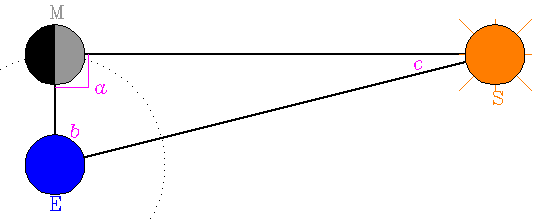
Aristarchus' geometric construction used to estimate the distance to the Sun. The Earth-Sun-Moon triangle and sizes are not drawn to scale.
While sound in theory, in practice this procedure is highly inaccurate in the Earth/Sun/Moon case; this is because EM is much smaller than ES, implying that b is very close to 90°, so that c is in turn very small. This has the consequence that a small measurement error on b translates in a large variation in the ratio EM/ES (again in modern parlance, a measurement error db is amplified by a factor 1/(sin c)2, which is large when c is very small). Aristarchus measured b=87°, while the true value is in fact 89° 50 minutes. This may seem a small error, but because of the large error amplification Aristarchus' value leads to EM/ES=19, instead of the true value EM/ES=397. Nonetheless, Aristarchus' calculation was the first to mathematically set the spatial scale of the cosmos.
References and further reading:
Van Helden, A. 1985, Measuring the Universe, University of Chicago Press.
Hirschfeld, A.W. 2001, Parallax, Freeman.
| Chronological menu | Biographical index | Index of images |
--------------------------------------------------------------------------------
968: The first mention of the solar corona
The solar corona is the hot, extended outer atmosphere of the Sun. It is far too faint to be seen against the blinding brightness of the solar disk itself, but becomes visible, and spectacularly so, at times of total solar eclipses when the solar disk is obscured by the Moon.
While the solar corona is visible at any solar eclipse, the first explicit mention of what can be pretty ambiguously interpreted to be the corona was made by the Byzantine historian Leo Diaconus (ca. 950-994), as he observed the total eclipse of 22 December 968 from Constantinople (now Istanbul, Turkey). His observation is preserved in the Annales Sangallenses, and reads:
"...at the fourth hour of the day ... darkness covered the earth and all the brightest stars shone forth. And is was possible to see the disk of the Sun, dull and unlit, and a dim and feeble glow like a narrow band shining in a circle around the edge of the disk".
Compare this description to the modern eclipse photographs shown on slides 9 and slide 10 of the HAO slide set. A much older possible description of the corona is said to be found on engraved oracle bones dating from the Shang dynasty in China (1766 to 1123 BC), but is far more ambiguous and open to interpretation than Diaconus' description.
References and further reading:
Hetherington, B. 1996, A chronicle of pre-telescopic astronomy, John Wiley and Sons.
| Chronological menu | Biographical index | Index of images |
--------------------------------------------------------------------------------
1128: The first sunspot drawing
This drawing, from the Chronicles of John of Worcester (one of the many monks who contributed to the Worcester Chronicles), represents to the best of our knowledge the first surviving sunspot drawing, from a sighting on Saturday, 8 December 1128. Compare it with the sunspots seen on Slide 1 and Slide 3 of the HAO slide set.
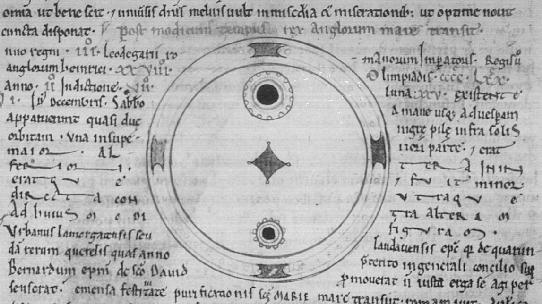
Sunspot drawing in the Chronicles of John of Worcester, twelfth century. Notice the depiction of the penumbra around each spot. Reproduced from R.W. Southern, Medieval Humanism, Harper & Row 1970, [Plate VII].
The accompanying text translates to something like: "...from morning to evening, appeared something like two black circles within the disk of the Sun, the one in the upper part being bigger, the other in the lower part smaller. As shown on the drawing." The facts that the Worcester monks could apparently distinguish the umbrae and penumbrae of the sunspots they observed suggests that the spots must have been truly exceptionally large.
Large sunspots can be visible to the naked-eye under suitable viewing conditions, for example when the sun is partially obscured by clouds or mist, particularly at sunrise or sunset. Numerous such sighting exist in the historical records, starting with Theophrastus (374-287 B.C.) in the fourth century B.C. However, by far the most extensive pre-telescopic records are found in the far east, especially in the official records of the Chinese imperial courts, starting in 165 B.C. In the West, the dominating views of Aristotle concerning the incorruptibility of the heavens meant that sunspots were "physically impossible", so that sightings were ignored or ascribed to transit of Mercury or Venus across the solar disk.
References and further reading:
Van Helden, A. 1996, Galileo and Scheiner on sunspots, in Proc. Am. Phil. Soc., 140, 358-396.
| Chronological menu | Biographical index | Index of images |
--------------------------------------------------------------------------------
1185: The first description of solar prominences
Prominences are large accumulation of (relatively) cold gas held suspended high in the solar atmosphere by the Sun's magnetic field (see Slide 6 and Slide 7 of the HAO slide set). Large prominences are often visible at times of solar eclipses, in the form of small reddish filaments or blobs in the lower corona. The first fairly unambiguous description of prominences is usually taken to be that found in the Russian Chronicle of Novgorod, in the following description of the 1 May 1185 solar eclipse:
"In the evening there as an eclipse of the sun. It was getting very gloomy and stars were seen ... The sun became similar in appearance to the moon and from its horns came out somewhat like live embers."
References and further reading:
Sviatsky, D. 1923, Astronomy in the Russian Chronicles, Journal of the British Astronomical Association, 33, 285-287.
Hetherington, B. 1996, A chronicle of pre-telescopic astronomy, John Wiley and Sons.
| Chronological menu | Biographical index | Index of images |
--------------------------------------------------------------------------------
1543: The Sun moves to center stage
The cosmos of the late Christian medieval era was a fusion of ideas combining the physics of Aristotle and the planetary astronomy of Ptolemy. This is the world view that was destroyed in the sixteenth and seventeenth centuries. The first blow was dealt by Nicholas Copernicus (1473-1543), who published his landmark book De Revolutionibus Orbium Coelestium in 1543. There Copernicus presented a new planetary model with the Sun placed in center, and letting all planets (including the Earth) orbit around the Sun. Copernicus also gave the Earth two additional motions: a daily axial rotation, and a precession of that spin axis. In doing so, Copernicus eliminated the need for the two outermost spheres of the ptolemaic model and produced a system where the speeds of revolution decrease gradually outward all the way to the fixed stars.
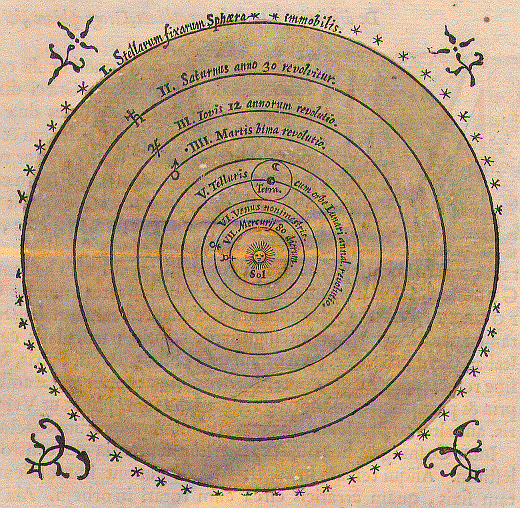
The Copernican planetary model. The Sun is at the center of all planetary motions, except for the Moon which orbits Earth. Under this arrangement the orbital speed of planets decreases steadily outwards, and the outer sphere of fixed stars is truly motionless. In Copernicus' original model the Earth has three motions: a daily 24-hr axial rotation, a yearly orbital motion about the Sun, and a third motion, somewhat related to precession which Copernicus thought necessary to properly reproduce ancient observations.
Copernicus ostensibly introduced his heliocentric model in order to do away with equants and various motions previously attributed to the sphere of fixed stars, but it appears clear that he believed in the physical reality of his heliocentric hypothesis. Because Copernicus' model could be construed as yet another mathematical device useful in astronomy but without physical reality, his model could at first be used by astronomers without attracting the ire of philosophers and theologians committed to the centrality and fixity of the Earth. This situation was to change in the next century.
References and further reading:
Kuhn, T.S. 1957, The Copernican Revolution, Harvard University Press.
Boas, M. 1962, The Scientific Renaissance 1450-1630, Harper & Row [Dover reprint available].
Gingerich, O. 1993, The Eye of Heaven, New York: American Institute of Physics.
Grant, E. 1994, Planets, Stars, & Orbs. The Medieval Cosmos, 1200-1687, Cambridge University Press
| Chronological menu | Biographical index | Index of images |
--------------------------------------------------------------------------------
1609: The Sun in focus
An early convert to the Copernican system was Johannes Kepler (1571-1630). After ten years of laborious work using the accurate observations of planetary positions accumulated over 20 years by the astronomer Tycho Brahe (1546-1601), Kepler came to realize that the orbital paths of planets has the form of ellipses with the Sun at one focus, and that the radius vector joining a given planet to the Sun sweeps equal areas in equal time (today known as Kepler's first and second laws). In 1609 Kepler published his landmark Astronomia Nova, and in 1619 his Harmonice mundi, where what is now known as Kepler's third law (orbital period squared proportional to mean distance cubed) is first laid out. Using his planetary model and Brahe's observations, Kepler produced in 1627 the Rudolphine Tables of planetary positions. These proved more accurate, by over an order of magnitude, than previous tables produced using the original planetary model of Copernicus.
References and further reading:
Thoren, V.E. 1989, Tycho Brahe, in The General History of Astronomy, vol. 2A, eds. R. Taton and C. Wilson, Cambridge University Press, pps. 3-21.
Gingerich, O. 1989, Johannes Kepler, in The General History of Astronomy, vol. 2A, eds. R. Taton and C. Wilson, Cambridge University Press, pps. 54-78.
Gingerich, O., and Voelkel, J.R. 1998, Journal for the History of Astronomy, 29, 1-34. Physics.
| Chronological menu | Biographical index | Index of images |
--------------------------------------------------------------------------------
1610: First telescopic observations of sunspots
In the first decade of the seventeenth century, four astronomers more or less simultaneously turned the newly invented telescope toward the Sun, and noted the existence of sunspots. They were Johann Goldsmid (1587-1616, a.k.a. Fabricius) in Holland, Thomas Harriot (1560-1621) in England, Galileo Galilei (1564-1642) in Italy, and the Jesuit Christoph Scheiner (1575-1650) in Germany.
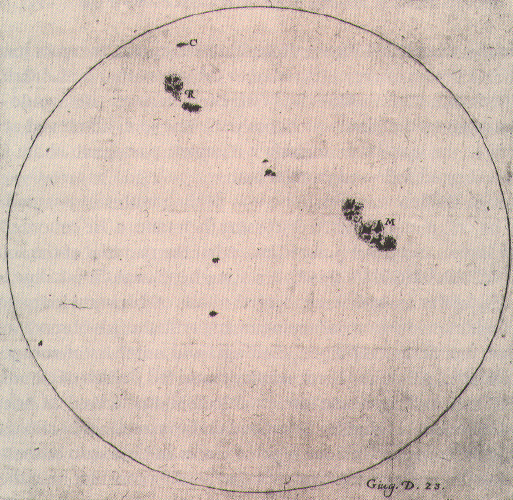
Reproduction of one of Galileo's sunspot drawings. The umbrae/penumbrae structure is clearly depicted on this June 23 1612 drawing.
To Harriot belongs the oldest recorded sunspot observation, on December 8 1610, as evidenced by entries in his notebooks, but he did not pursue these observations in any systematic or continuous manner at the time. Fabricius was the first to publish his results in 1611, and correctly interpreted the apparent motion of sunspots in terms of axial rotation of the Sun. Galileo and Scheiner, however, were the most active in using sunspots to attempt to infer physical properties of the Sun. To Galileo belongs the credit of making a convincing case that sunspots are indeed features of the solar surface, as opposed to intra-Mercurial planets (Scheiner's original position). Galileo's views were first laid out in detail in his 1613 Letters on Sunspots, written in response to Scheiner own views on the matter, first published in 1612 under the bpseudonym of Apelles in the form of three letters to Mark Welser (1558-1614), Augsburg Magistrate, patron of science, and scientific correspondent of both Scheiner and Galileo. Some years later Scheiner, in his massive 1630 treatise on sunspots entitled Rosa Ursina, accepted the view of sunspots as marking on the solar surface and used his accurate observations, to infer the fact that the Sun's rotation axis is inclined with respect to the ecliptic plane (i.e., the plane of the Earth's orbit around the Sun).
The existence of ephemeral blemishes on the Sun's surface was in stark conflict with the then prevailing Ptolemaic/Aristotelian-based cosmology endorsed by the Roman catholic Church (after suitable modification to avoid open contradiction with the Scriptures). Galileo's views on sunspots contributed significantly the sequence of events that landed him in front of the Roman Inquisition in 1633. Officially, Galileo was condemned for disobedience to the Church, in the context of his open endorsement of the Copernican heliocentric planetary model. Growing animosity on the part of the Jesuits who, in particular through their chief astronomer Christopher Clavius (1538-1612), had been originally quite supportive of Galileo's early telescopic discoveries, also contributed to Galileo's downfall.
References and further reading:
Galileo, G. 1610, Sidereus Nuncius, trans. A. van Helden 1989, The University of Chicago Press.
Galileo, G. 1613, Letters on Sunspots [in S. Drake (trans.) 1957, Ideas and Opinions of Galileo, Doubleday].
Galileo, G. 1632, Dialogues concerning the two chief world systems, trans. S. Drake, 2nd edition 1967, University of California Press.
Mitchell, W.M. 1916, The history of the discovery of the solar spots, in Popular Astronomy, 24, 22-ff.
Shea, W.R. 1970, Galileo, Scheiner, and the interpretation of Sunspots, Isis, 61, 498-519.
Drake, S. 1978, Galileo at work: his scientific biography, Chicago: The University of Chicago Press [1995 Dover reprint]
| Chronological menu | Biographical index | Index of images |
--------------------------------------------------------------------------------
1644: The Sun as a star
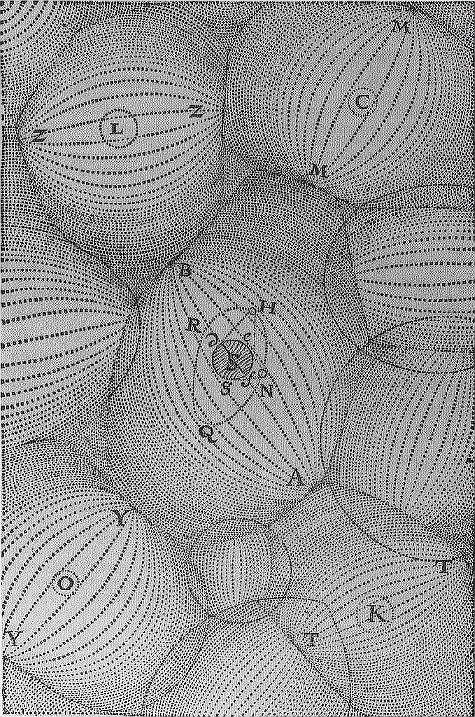
Detail of a diagram from the 1644 Principia philosophiae of René Descartes, depicting his conception of the cosmos as an aggregate of contiguous vortices, most with a star at their center. S is the Sun.
The Copernican system replaced the Earth by the Sun as the center of the universe, but otherwise maintained a clear distinction between the Sun, and the "fixed" stars, distributed on the fixed, outermost sphere of the copernican cosmos. This last concession to humanity's cosmic centrality was rejected by the generation of copernicans following Kepler and Galileo. Prominent among them was René Descartes (1596-1650) who, in his 1644 book Principia philosophiae, put forth a model of the cosmos where the Sun is but one of many star, each of which having formed at the center of a primeaval vortex. Descartes viewed sunspots as floating aggregates of etheral matter, accreted along the Sun's rotational axis, where centrifugal forces are negligible.
References and further reading:
Aiton, E. J. 1989, The Cartesian Vortex Theory, in The General History of Astronomy, vol. 2A, eds. R. Taton and C. Wilson, Cambridge University Press, pps. 207-221.
| Chronological menu | Biographical index | Index of images |
--------------------------------------------------------------------------------
Further Readings on the history of solar physics.
Other Web Sites with material on the history of solar physics.
--------------------------------------------------------------------------------
Go to later Great Moments
--------------------------------------------------------------------------------
Did you find factual errors in any of the above documents? If so, we really want to know! please e-mail paulchar@astro.umontreal.ca
--------------------------------------------------------------------------------
-Written by paulchar@astro.umontreal.ca
-Last revised 22 December 1999 by paulchar@astro.umontreal.ca